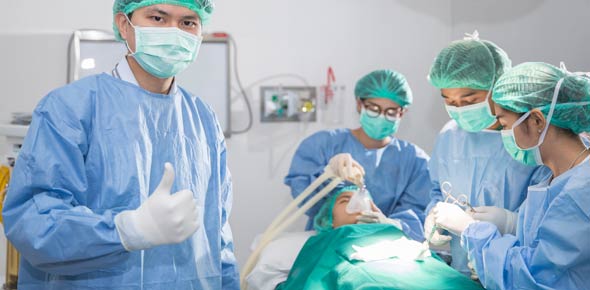Which type of suture would be used to invert the stump of an appendix?
Which condition regarding sterile technique in NOT recommended?
Which of the following is considered a break in technique?
Pathologic enlargement of the male beast is called
Which of the following specimens is NOT placed in preservative...
McBurney is an incision used for
When handing skin towels to the surgeon, where should the scrub person...
Another name for the Kraske position is
An important consideration during cholangiogram is to
Before handing a Penrose drain to the surgeon
A closed-wound suction system works by
In which hernia is the blood supply of the trapped sac contents...
Each of the following actions by a scrub person prevents wounds and...
Why are gowns, gloves, drapes, and instruments changed following a...
The correct procedure for sterile dressing application is
Intraabdominally, lap pads are most often used
Thrombosed vessels of the rectum are known surgically as
In an extreme patient emergency, a sponge count
Cultures obtained during surgery
Which of the following is NOT an acceptable technique when draping a...
The procedure to follow if a hair is found on the operative field is...
A Whipple operation is surgically termed a
Cancer technique in surgery refers to
In a gastrointestinal closure, the mucosa of the intestinal tract is...
The curved transverse incision used for pelvic surgery is
Which organ is removed either because of trauma, a blood condition, or...
Following a hemorrhoidectomy, a
When a sterile item is hanging or extending over the sterile table...
Which breast procedure removes the entire breast and axillary contents...
When drop technique for an intestinal procedure is utilized
The instrument most commonly used to grasp the mesoappendix during an...
An entire tumor/mass removal is termed
A procedure done to give the colon a rest and is the reversed is
A left subcostal incision indicates surgery of the
Why are bumpers or bolsters used on retention sutures?
The disposable circular staple designed to hold two tubular strutures...
During an appendectomy, a purse-string suture is placed around the...
How is a frozen section sent to the lab?
The intestinal layer in order, from inside to outside, is
A hernia occurring in Hesselback's triangle is called
A dissecting sponge that is a small roll of heavy cotton tape is a
An enzyme extract from bovine blood used as a topical hemostatic agent...
An abdominal wall defect may be reconstructed using
A common postoperative patient complaint following a laparoscopic...
Sutures placed in a wound to prevent wound evisceration are called
Which procedure would not require a pressure dressing?
A postoperative complication attributed to glove powder entering a...
Peanuts and dissecting sponges are generally
A catheter commonly used in a gastrostomy is a
In a cholecystectomy, which structures are ligated and divided?
Dark blood in the operative field may indicate that the patient is
A Nissen Fundoplication procedure is done to correct
In which situation should sterility be questioned?
The simplest abdominal incision offering good exposure to any part of...
The Sengstaken-Blakemore tube is used for
The desirable position for better visualization in the lower abdomen...
In a pilonidal cystectomy, the defect frequently is too large to close...
An instrument used to elevate the thyroid lobe during surgical...
All of the following are helpful in keeping accurate account of...
If the floor or wall becomes contaminated with organic debris during a...
Which gallbladder procedure ALWAYS requires intraoperative x-rays?
What incision is indicated for an esophagogastrectomy?
A lower oblique incision is a (n)
Mersilene is a (n)
Surgical enlargement of the passage between the prepylorus of...
The breast procedure performed to remove extensive benign disease is a...
Which hernia leaves the abdominal cavity at the internal inguinal ring...
Gastrointestinal technique is required in all of the following...
A common complication of extubation is
Vaporization and coagulation of hemorrhoidal tissue can be...
All of the following statements refer to pilonidal cyst surgery EXCEPT
Transduodenal sphincterotomy refers to the incision made into the...
Irrigating fluid used to flush the organ between harvest and...
A specially treated form of surgical gauze that has a hemostatic...
In which incision could retention sutures be used?
Portal pressure measurement is indicated in
A benign anal wall "slit" type of lesion requiring excision...
A surgical procedure performed to relieve esophageal obstruction...
A subphrenic abscess occurs in the
The term transduldenal sphincterotomy indicates surgery of the
In which hernia does the herniation protrude into the inguinal canal...
















